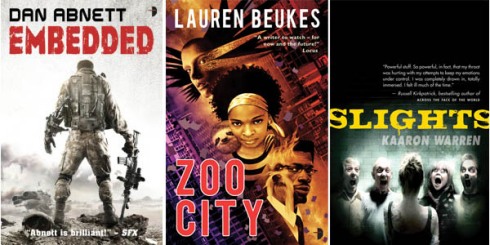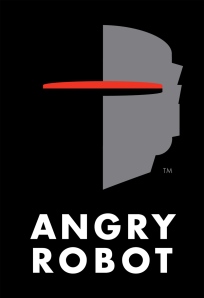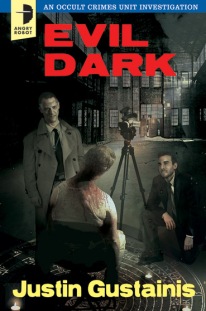
Shelf Candy is a weekly meme hosted by the lovely Five Alarm Books. This meme gives us an opportunity to highlight a cover we love and the artist who created it. Please click the button above to find out how to participate and to see what other covers are being discussed this week.
***
WHY I LOVE THIS COVER
This is another cover that really stands out on store shelves. I love its retro/pin-up feel and the choice of color. The use of pink in the text and on Verity Price’s clothes are a nice contrast with the dark background. There is a sense of humor in the cover that I appreciate – a mix of light and dark that I think fits with the story.
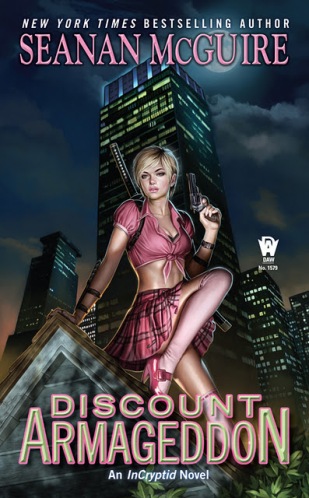
The cover was designed by the UK-based illustrator/artist Alistair (Aly) Fell. I bombarded Aly with a lot of questions and I considered cutting some out for this final post but I couldn’t bring myself to do it. I loved his answers and I am excited to share this with you. Special thanks to Aly for his patience with my interrogation!
Please welcome, Aly Fell!
SWR: Can you tell me a little about your art background and how you got started in cover illustration? What was the moment of no return in which you knew this is what you wanted to do professionally?
I don’t know how true it is for other ‘artists’, but to me there wasn’t really any doubt I’d end up doing something with art from the day I first picked up a pencil. Either that or a career making spaceships or trains out of Legos! My parents would say to my sister and me: “draw us something”, rather than plonk us in front of the television, and I’m forever grateful to them for that. I nearly always ended up drawing women; Joan of Arc was a favourite of mine along with Lady Jane Grey for some reason. I don’t know what psychologists would make of that, an obsession with the tragic female ideal maybe, (let’s face it, the Pre-Raphaelites made a career out of it!), but it’s a theme that grew into an attempt to present women as human beings in ‘situations’ rather than as objects or simply muses. I mean, I love pin-up art, Gil Elvgren is a favourite of mine, but something I’m always aware of with pin-up is ‘the male gaze’. I attempt to draw women for not just men, but to give them an independence from that default. Not exclusively, and at times it doesn’t always work either, but that’s my aim.
My art training was pretty standard, from a UK perspective: A level art, a foundation course, then a diploma in graphic design. I was turned down by Corsham College in Bath, where I was given a grueling interview, because I drew women and silly animals! (Too much reading of Heavy Metal Magazine I expect). All throughout my education I was told I’d never get anywhere doing what I did at the time. Despite getting a fair basic education, it was up to me to find what I wanted to do in my spare time, and just stick with it.

Danger Mouse - animated TV series
Almost by accident I ended up at Cosgrove Hall Films in Manchester working in animation as an “inbetweener.” I ended up animating on shows and features, ‘Dangermouse’, ‘Count Duckula’ etc, and in 2000, as animation was definitely going through a slump, I moved into games. It was about then my wife got very ill and I decided it was time to rethink where I was going, and where my priorities lay. So I quit the job, crossed my fingers and decided to go freelance. ‘Covers’ have come along as part of that, and have been wonderful!
SWR: Tell me the story of how you got involved with the Discount Armageddon project?
I was approached by Sheila Gilbert at DAW books via email. Apparently Seanan McGuire had seen my work online somewhere, and it was rather lovely to learn she was keen for me to do the cover to her new novel ‘Discount Armageddon’! I was enormously flattered and happy, but it came at probably the busiest point I’ve had so far in my freelance career. I was completing a tarot pack, and still had about 30 cards to do in a really short space of time comparatively, so I initially said it would be almost impossible for me to do the cover. Then I learned that Seanan was really keen, and with a bit of juggling of dates, we worked something out! And I’m so happy we did! Seanan and Sheila have been wonderful and extremely patient to work with, and the book made it in to the New York Times Bestseller list as well!
SWR: What was the concept behind the cover and how much collaboration was involved between you, Seanan McGuire, and the publisher?
From the outset, Seanan and Sheila had a good idea of what they wanted for the cover. I love working with Art Directors who know what they want. Some illustrators love to hear the phrase, ‘just come up with something’. But what I love to hear is ‘this is what we want, and this is how we want it’. You can then do it! Of course there is room for your input as the artist. That’s hopefully why they want you, but you know where you can go with what you’re doing, what the parameters are.
Here the requirements were a simple character representation, in an almost ‘Frazetta triangle’, but instead of lots of skulls and a half naked barbarian, she was a waitress in pink on a rooftop, but a kick arse waitress in pink! Seanan had a definite vision of whom the main character should look like, so I sought out references and tried to capture the essence without doing a straight copy. It often helps a writer to know what your character looks like, but it helps an illustrator more, because that character has to be channelled somehow into a visual image.
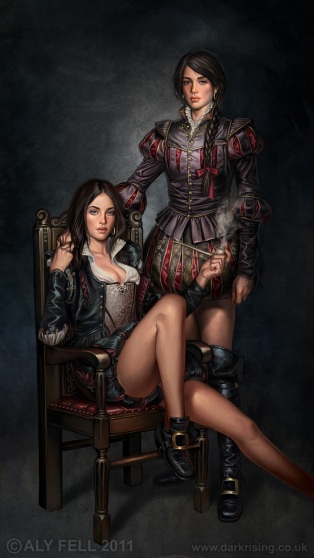
Rosalind and Celia - As You Like It by Aly Fell
SWR: How would you describe your style and what, or who, are some of your influences?
It’s difficult when asked to describe your style. Sometimes it’s easier to compare it to others, as though it can then be compartmentalised, boxed. ‘Oh Aly Fell, he’s that pin-up artist!’ I don’t know if I have a ‘style’, but I do have a slight mission, and that, as I’ve said before, is to present women as people, not just a series of curves and aesthetics. It’s one of the reasons clothing is so important in my images, it presents part of their character and their world. Another thing which I try for is self-awareness: the women are not passive, or at least rarely so. So they look at you from the image, not in a ‘come hither’ way, but in a ‘knowing’ manner, as though you’re invited but on their terms, not yours. Humour can be a great way to cushion this. I don’t get the ‘half naked chick and snake monster’ thing. It’s fun when someone like Frazetta does it, but if you were a warrior woman, wouldn’t you smother yourself in protective clothing rather than a bikini bottom and a chain mail bra? And that’s what I mean about the ‘male gaze’: those illustrations are not for women, as a rule, but for men. And it’s not an argument that the men are half naked too, because it’s about power-play and the ‘male default’ in all things. But hey, I like looking at those images too! I grew up on Frazetta, but I find a more interesting subtlety in the work of Jeffrey Catherine Jones who often painted similar themes. Art is incredibly subtle in the way it communicates to us. There’s often a lot more going on in imagery than we think there is. Jeff Jones is an example of that.

Oscar Wilde by Aly Fell
Alongside Jones, my artistic influences and ‘likes’ are really varied: J W Waterhouse, Moebius, Arthur Rackham, Edmund Dulac, John R Neill (illustrator of the OZ books), Robert McGinnis, Miro, Mucha, Kay Neilsen, Don Lawrence, Austin Osman Spare, Aubrey Beardsley, Beresford Egan (all three masters of line)… I could go on and on! But I have a real fondness for illustrators that were working out of the UK during the golden age of illustration, Dulac, Rackham, Neilsen and lesser known examples like Florence Harrison, whom I tried specifically to emulate with an image of mine called ‘The Winter Queen’. Then there are the American illustrators like N C Wyeth, Dean Cornwell, Rockwell, Leyendecker etc.

The Winter Queen by Aly Fell
SWR: You’ve worked on some well-known animated series, including Danger Mouse, during your time a Cosgrove Films. What kind of impact did that experience in animated television have on the development of your style and/or your process?
Working in animation as an animator provides an almost unparalleled experience in the learning and understanding of movement and form. You have to work very quickly to capture the essence of an action or gesture, emotion or personality, in not just one drawing but a series of them. As an illustrator, I tend to start an image exactly the same way I would start animating a scene, in that I try to get the essence down as immediately as possible with a simple and gestural scribble. Sometimes starting with ‘a circle for their head’ and then moving out from that. The white page is terrifying, and just getting some kind of mark down shatters that fear. It becomes a focus and a ‘seed.’
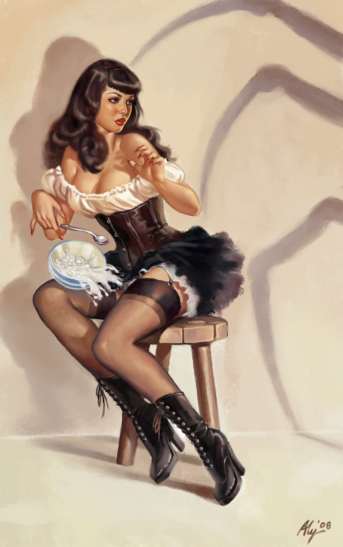
Betty Paige by Aly Fell
SWR: What is your creative process? For example, once you get the creative brief or the concept for a cover, what is your next step? What is the process that takes you from the concept to the finished piece?
I don’t think I’m unusual in my creative process when I get a brief. I work on a Cintiq, a digital drawing board that is just like a real one, but draws straight into the application on the PC. As a result I don’t have to scan and photograph line-work or roughs and can just get straight on with it. I start with the brief, and sketch out quickly some poses and any background that is required, usually very roughly trying to catch the bones of what I’m after. I’ll do a few options, and save them all off as small jpegs. These then go to the client and they can get an idea of composition, and then offer feedback and/or changes. The strongest covers are often the simplest, not least because they’re less arduous to paint, but because they have to sell the book and simplicity is less demanding when browsing book covers. Getting across the fundamentals of a story in as few elements as possible is sometimes harder as well. A cover is a big advert, or to some extent a condensed version of the book honed down. Complicated compositions can often end up being confusing.
The rough for the cover of ‘Discount Armageddon’ was a joy to do and the composition chosen was also my favourite.

Once the rough is OK’d, I look for reference and tighten up the sketch so that it’s more like the finished composition will be. In this case I used little reference for the pose and plenty for the face, but spent ages looking at photos of skyscrapers. The fun bit for me is always the character, not the environment, but it does have to support the image. With ‘Discount Armageddon’, the background was pretty simple, and that was just great to be allowed to concentrate on the character! I then block in colour and tone, sometimes working in greyscale first, and then start detailing the face. I almost always start with the face, and work out from there, building up more detail as I go. The finished piece sort of sneaks up on you! You’re working away, doing it bit by bit, then suddenly you realise anything more wouldn’t be adding to it, wouldn’t make it any better, and may have a converse effect. So usually at this point I send a version to the client, seeking a new set of eyes on it. There will nearly always be some sort of change; quite rightly so if there’s an element not appropriate or any drifting from the brief. So I make those changes and resend, crossing my fingers! Once again, it was an absolute pleasure to work with Seanan and Sheila, and they signed off pretty much with what I did.

The Death Dealer by Aly Fell
SWR: If you could create a cover for any one book, what book would that be and why?
When I was younger, I loved the stories of H Rider Haggard, ‘King Solomon’s Mines’, ‘Montezuma’s Daughter’, ‘She’ etc. They’re a little dated now, compared with the writing of Haggard’s contemporary Conan Doyle, who still reads as fresh as ever, but I have a soft spot for Haggard’s strong female characters and a fantasy world that seemed much more real than Hyperborea or Middle Earth, because it was more than often the ‘still being discovered’ Africa (at least by generally rich white Victorian men). So I’d love to do a cover for ‘She’. And maybe ‘The Arabian Nights’… or ‘Alice’s Adventures in Wonderland’… But probably ‘She’ would be the one. It was a classic tale, turned into a none-to-bad Hammer movie in the 60’s, and at least 8 or 9 other versions, one of which being from 1899 makes it amongst the oldest stories ever filmed!
SWR: Can you give us any hints about your upcoming cover work?
As for future covers, Seanan wants me to do the next in the ‘Discount Armageddon’ series. I’m also doing a series of young adult books for Simon and Schuster. I’ve recently had an adapted image used by Christopher Moore for his latest novel, ‘Sacre Bleu’, in a completely different style to my other work. I’ll be also producing a cover for a UK publisher, but that’s still under an NDA, so more of that later…
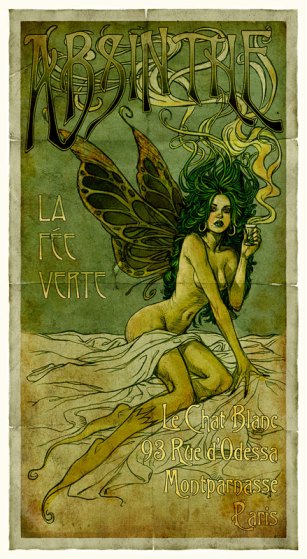
Absinthe Fairy by Aly Fell (This image was adapted for use on the cover of Christopher Moore's upcoming release, Sacre Bleu)
SWR: Finally, do you have any personal projects you would like to share with us?
As for personal work in the future, I have an erratic web-comic called ‘Rosie Poe’ about the adventures of a slightly cynical Goth girl. Erratic, depending on what other work I have coming in. I started a picture book ages ago I’d like to finish called ‘Little Michelle, Who’s Going to Hell’, which is in a bit of an Edward Gorey mould. I also have a set of collectible cards coming out from Cult Stuff, and a tarot deck from Llewellyn! Steampunk inspired, which includes some of my existing Steampunk characters. But I would also like to rediscover oils as I attempted to last year. Digital is great, but I want to get messy again with art.

***
Please take a moment to visit Aly and check out more of his incredible work:
WEBSITE | BLOG | AMAZON
And you can visit Seanan McGuire to find out more about her InCryptid Series here:
WEBSITE | TWITTER
***
I’ve featured some of my favorite pieces of Aly’s in this interview. Visit his website gallery and let me know which images are your favorites!
Happy Reading!


